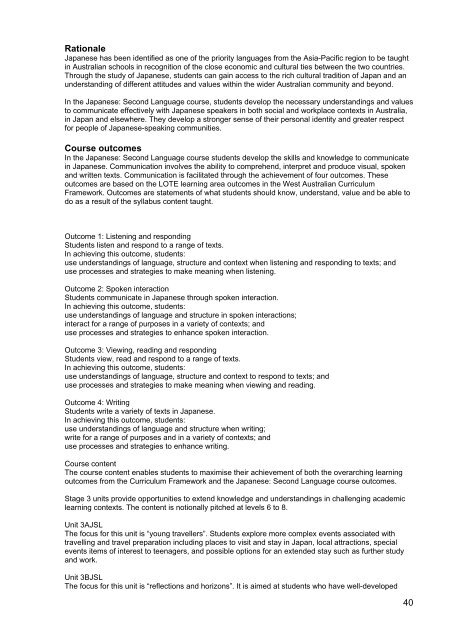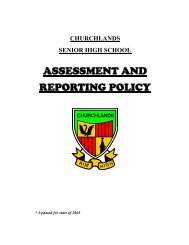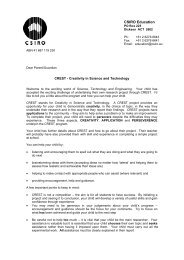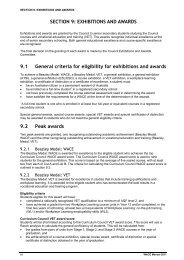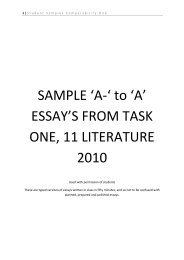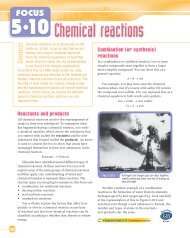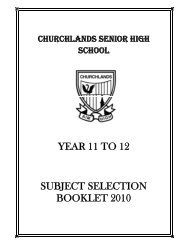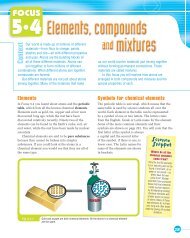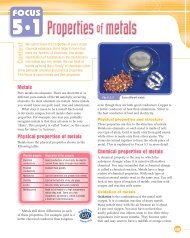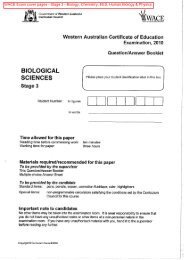3a/3b - Churchlands Senior High School
3a/3b - Churchlands Senior High School
3a/3b - Churchlands Senior High School
Create successful ePaper yourself
Turn your PDF publications into a flip-book with our unique Google optimized e-Paper software.
RationaleJapanese has been identified as one of the priority languages from the Asia-Pacific region to be taughtin Australian schools in recognition of the close economic and cultural ties between the two countries.Through the study of Japanese, students can gain access to the rich cultural tradition of Japan and anunderstanding of different attitudes and values within the wider Australian community and beyond.In the Japanese: Second Language course, students develop the necessary understandings and valuesto communicate effectively with Japanese speakers in both social and workplace contexts in Australia,in Japan and elsewhere. They develop a stronger sense of their personal identity and greater respectfor people of Japanese-speaking communities.Course outcomesIn the Japanese: Second Language course students develop the skills and knowledge to communicatein Japanese. Communication involves the ability to comprehend, interpret and produce visual, spokenand written texts. Communication is facilitated through the achievement of four outcomes. Theseoutcomes are based on the LOTE learning area outcomes in the West Australian CurriculumFramework. Outcomes are statements of what students should know, understand, value and be able todo as a result of the syllabus content taught.Outcome 1: Listening and respondingStudents listen and respond to a range of texts.In achieving this outcome, students:use understandings of language, structure and context when listening and responding to texts; anduse processes and strategies to make meaning when listening.Outcome 2: Spoken interactionStudents communicate in Japanese through spoken interaction.In achieving this outcome, students:use understandings of language and structure in spoken interactions;interact for a range of purposes in a variety of contexts; anduse processes and strategies to enhance spoken interaction.Outcome 3: Viewing, reading and respondingStudents view, read and respond to a range of texts.In achieving this outcome, students:use understandings of language, structure and context to respond to texts; anduse processes and strategies to make meaning when viewing and reading.Outcome 4: WritingStudents write a variety of texts in Japanese.In achieving this outcome, students:use understandings of language and structure when writing;write for a range of purposes and in a variety of contexts; anduse processes and strategies to enhance writing.Course contentThe course content enables students to maximise their achievement of both the overarching learningoutcomes from the Curriculum Framework and the Japanese: Second Language course outcomes.Stage 3 units provide opportunities to extend knowledge and understandings in challenging academiclearning contexts. The content is notionally pitched at levels 6 to 8.Unit 3AJSLThe focus for this unit is “young travellers”. Students explore more complex events associated withtravelling and travel preparation including places to visit and stay in Japan, local attractions, specialevents items of interest to teenagers, and possible options for an extended stay such as further studyand work.Unit 3BJSLThe focus for this unit is “reflections and horizons”. It is aimed at students who have well-developed40


